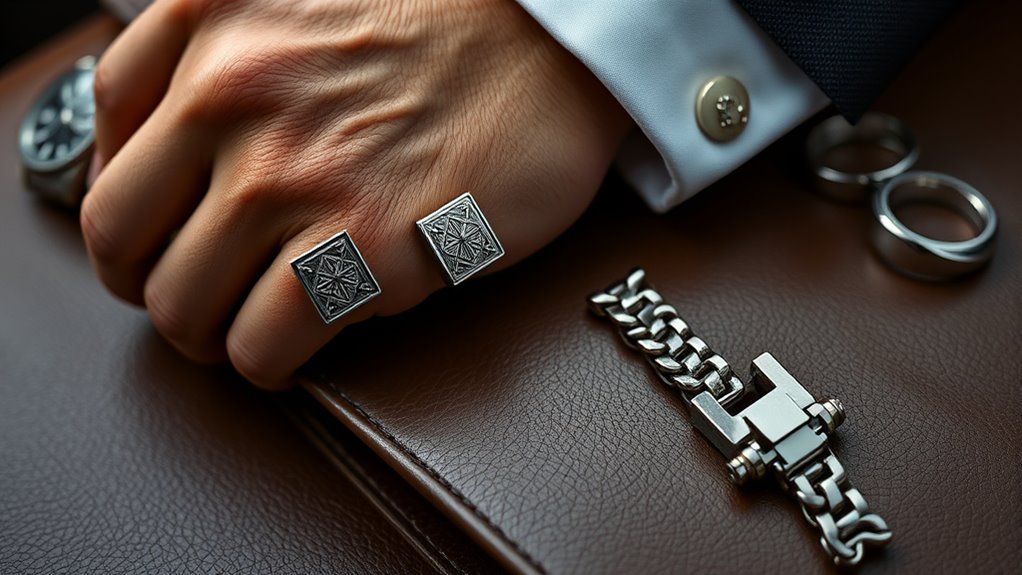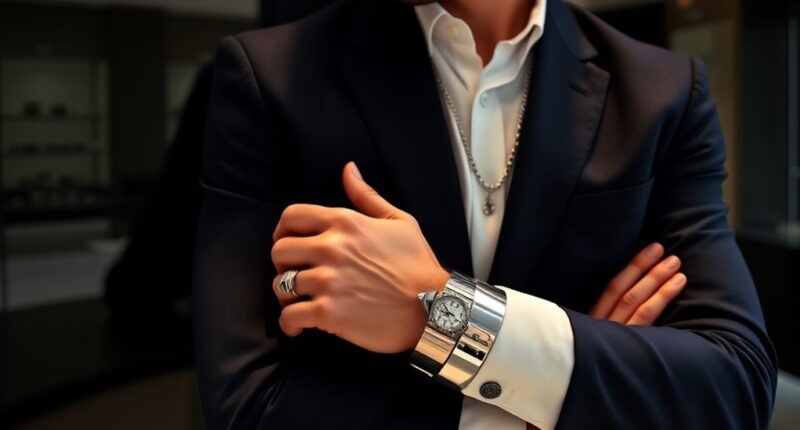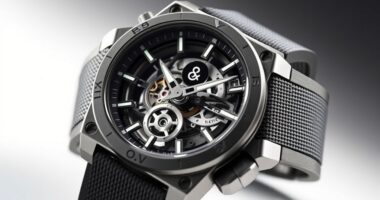Men’s jewelry is experiencing remarkable growth, outperforming the overall luxury market slump. Consumers are embracing personalized and bold statement pieces like chunky rings, pendants, and layered accessories that express identity and style. This trend is driven by a shift toward artisanal, sustainable designs and a desire for self-expression. As the market expands rapidly, enthusiasts like you will find exciting new options. Keep exploring to discover how this trend can elevate your personal style.

Despite a slowdown in the overall luxury market, men’s jewelry is experiencing significant growth. You might notice more men wearing bold, statement pieces that capture attention and reflect confidence. The global market is projected to hit USD 124.13 billion by 2034, with the US alone expected to grow from $5.45 billion in 2024 to over $10.75 billion by 2032 at an impressive 8.4% CAGR. This surge is driven by broader acceptance of men’s jewelry as a staple in everyday fashion, breaking away from traditional notions of masculinity and style. Increased consumer interest in unique designs You’re seeing a shift toward more personalized and customized jewelry options. Consumers now prefer artisanal pieces that express their identity, culture, and lifestyle. This trend moves away from mass-produced accessories, favoring limited-edition collections that create a sense of exclusivity and emotional connection. Brands are responding by offering engraved, bespoke designs, and experimenting with diverse materials and craftsmanship to satisfy individual tastes. Furthermore, gift spending during occasions such as holidays is contributing to the rise in popularity of men’s jewelry.
Design trends are evolving rapidly. In 2025, bold, statement-making jewelry is replacing subtle accessories. You’ll notice men opting for chunky signet rings, gemstone accents, and oversized pendants that boldly express their personality. At the same time, minimalist styles like slim silver chains and delicate gold bracelets are gaining popularity for their versatility and elegance. Pendant necklaces featuring geometric or symbolic motifs are particularly trendy, offering a modern, meaningful touch to everyday outfits. Mixed metal combinations—silver, gold, black tones—are also trending, creating contrasting, contemporary looks that appeal to fashion-forward consumers.
Natural aesthetics are also in vogue. Real stone bead bracelets, such as lava stones, offer tactile appeal and a sense of authenticity. Layered necklaces and stacked rings are increasingly popular, enabling you to create personalized looks that reflect your style. Search trends reveal high interest in “men’s rings” and “men’s necklaces,” especially during holidays and gifting seasons, indicating that jewelry remains a key expression of masculinity and personal style. Younger buyers, particularly on the West Coast and in the Northeast, are leading this charge, favoring eco-friendly, layered, and statement pieces that set them apart.
Interest in sustainable, minimalist, pearl, and stacked jewelry is rising, while demand for traditional heavy items like thick gold chains is declining. You’re likely to see more men seeking jewelry that combines style, meaning, and sustainability. As the market continues to expand, expect brands to innovate with new materials and designs, making personalized jewelry more accessible and reflective of individual identity. This growth underscores how men’s jewelry is no longer just an accessory but a powerful form of self-expression and style.
Frequently Asked Questions
How Do Men’s Jewelry Trends Differ Across Regions?
You’ll notice regional men’s jewelry trends vary markedly. In North America, preferences range from sustainable, fashion-forward West Coast styles to luxury-focused Northeast pieces. Europe favors bold mixed metals and personalized designs, while Asia-Pacific emphasizes minimalism and cultural motifs. The Middle East prefers ornate gold jewelry, and Latin America blends vibrant beads with handcrafted accents. These differences reflect cultural values, fashion influences, and regional traditions shaping men’s jewelry choices worldwide.
Which Materials Are Most Popular in Men’s Jewelry?
You see gold, silver, platinum, and stainless steel shaping men’s jewelry, each offering a distinct vibe. Gold dazzles with its timeless appeal, silver shines in its versatility, platinum exudes luxury, and stainless steel provides modern strength. Alongside these metals, natural stones, beads, and leather add texture and personality. These materials come together in layered, personalized designs—creating bold statements, subtle accents, and everything in between, truly capturing your unique style.
What Demographic Is Driving Men’s Jewelry Sales?
You’re driving men’s jewelry sales, primarily through the 25-34 age group, which makes up 35% of buyers and spends the most. The 35-44 demographic also contributes considerable, while younger trend-driven buyers aged 18-24 influence social media trends. Higher-income men, especially those earning over $75,000, are key purchasers of premium pieces. Your focus on fashion-forward, quality, and occasion-based buying fuels ongoing growth across these demographics.
Are Online Platforms the Main Sales Channels for Men’s Jewelry?
Online platforms act like digital highways for men’s jewelry, steering a growing wave of sales. While they’re not the main roads yet, accounting for about 20-33% of total sales, their influence is expanding rapidly. You’ll find these virtual avenues essential for discovery, personalization, and convenience, especially with younger, tech-savvy consumers. They often complement offline stores, creating a seamless journey where exploration and purchase happen at your fingertips.
How Sustainable Are the Materials Used in Men’s Jewelry?
You’ll find that many men’s jewelry brands prioritize sustainability by using recycled metals like silver, gold, and copper, which reduces environmental harm. They often opt for lab-grown gemstones, eliminating issues tied to mining. These materials come from waste sources and are reclaimed, lowering their carbon footprint. Brands also follow strict ethical standards, ensuring fair sourcing and transparent supply chains, making your jewelry not only stylish but environmentally and ethically responsible.
Conclusion
As you watch the men’s jewelry market thrive despite the luxury slump, it’s clear how unexpected successes often happen when least expected. Just as the industry shifts, you realize that opportunity and challenge often walk hand in hand. So, stay attentive, because what’s rising now might just be the next big thing you didn’t see coming. In a world of surprises, sometimes the most unlikely wins are the ones that truly catch your eye.









